Replacement liver for simulation of keyhole surgery
Sylvia Donner, Marc Kraft
TU Berlin, Germany ZMMS, GRK prometei/ FG Medizintechnik
In medicine and medical technology, animal tissues – in most cases pig tissue – are often used for testing products or devices that are intended for use on humans. Like all natural materials, animal tissue is also subject to strong fluctuations, and (mechanical) material parameters vary strongly. Reproducible experimental conditions can therefore only be guaranteed to a limited extent. Storage conditions, age of the sample and the particularity of the animal are some of the most important factors influencing the properties of animal materials.
In order to simulate a so-called keyhole surgical procedure – a laparoscopic gall bladder removal – a replacement tissue for the liver had to be found. In this intervention, the gall bladder positioned under the liver is removed via three to four small skin cuttings in the abdominal wall. In contrast to conventional procedures, the abdominal wall remains virtually closed.
An advantage for patients, a challenge for surgeons
Patients benefit greatly from this procedure – compared to open surgical procedures the pain experienced is significantly less, and leads to a better cosmetic result due to reduced scarring.
On the other hand, the freedom of movement and vision for the surgeon is severely limited. Surgery is only possible by using specialized instruments (Fig. 1). Performing surgery under these conditions presents physical challenges for the surgeon, some of which can be attributed directly to the instruments used [2]. This is why guidelines for the design of laparoscopic (gripping) instruments are currently being developed to take into account not only the safety of the patient but also the ergonomic aspects for the surgeon. However, for ethical reasons measurements during real surgical procedures are not feasible at all or only with considerable restrictions.
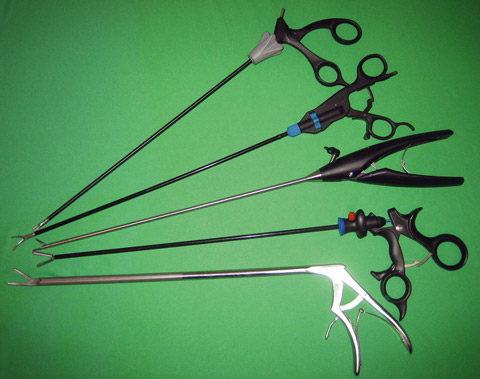 Figure 1: Surgical instruments used in keyhole surgery (‘minimal invasive surgery’)
Figure 1: Surgical instruments used in keyhole surgery (‘minimal invasive surgery’)
The liver is in the way
During a gall bladder removal, the liver plays an important role, especially due to the anatomical proximity of both organs. During surgery or simulation, the liver must be held to the side for a relatively long time to obtain access to the gall bladder, which is why a uniform replacement material is required that is equipped with similar gripping properties. For this purpose, tensile strength tests were carried out on pig liver samples in order to determine the mechanical material parameters of an average pig liver.
So far, relatively little research has been carried out on material parameters of animal tissues. The techniques described in a standard work by Yamada [5] are no longer state-of-the-art. For instance, Yamada describes tensile tests using suspended weights on a relatively small number of samples. The tensile properties were based on tensile tests carried out in 1953 on several rabbit livers. Due to the methodology they were presented in g/mm2. In more recent research, these classical tensile tests were abandoned in favor of other methods. Mazza, for instance, used compression tests on the liver of living patients to determine the material parameters in 2008 [3].
How to find ‘replacement livers’
In order to determine the material parameters, experiments had to be carried out. Due to the lack of test specifications, own test routines had to be developed. These were built upon existing standards, such as DIN EN ISO 527 for the determination of tensile properties of plastics [1]. The tensile tests were carried out at room temperature (approximately 20 °C), on a 20 N Shimadzu AGS-X universal testing machine (Figure 2).
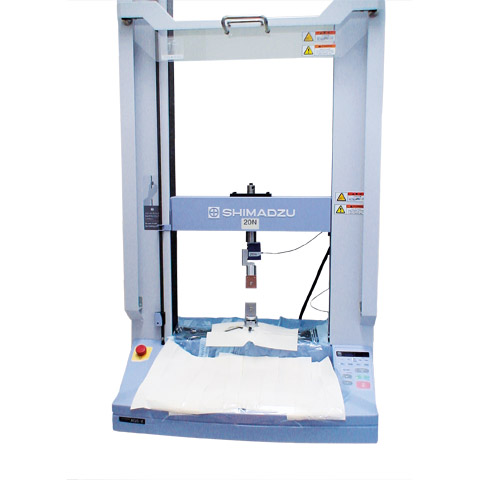 Figure 2: Shimadzu’s AGS-X universal testing machine specially prepared for the experiments and used in the tensile tests
Figure 2: Shimadzu’s AGS-X universal testing machine specially prepared for the experiments and used in the tensile tests
Clamping a total of 52 standardized pig liver samples with portions of exterior tissue presented a challenge. Due to the particular consistency of the animal tissue, existing clamping devices could not be used. The spring grips used next destroyed the samples because the local pressure load was too high. This is why own clamping devices have been designed to clamp all samples (Figure 3). The samples were stretched with the AGS-X universal testing machine at a rate of one Newton per minute until rupture. Own MATLAB® algorithms (The MathWorks) have been used to analyze the raw data.
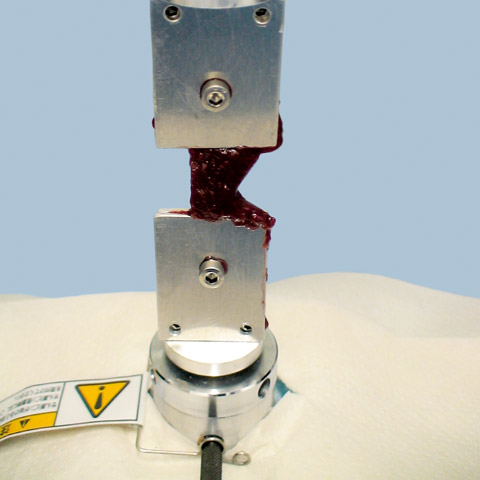 Figure 3: Clamped pig liver sample
Figure 3: Clamped pig liver sample
As expected, the stress-strain curves obtained exhibited strong scattering. For the evaluation, it was therefore necessary to firstly define rogue results for which the maximum stress lies outside the range between the lower and upper quarter of the samples.
Of the remaining data sets, mean values were established and a best-fit curve, a polynomial of the 9th order, was approximated. The curve had a linear range and the elastic modulus could therefore be determined as 6.28*10-2 N.mm2 (62.8 kPa) at an elongation of 54 % (Figure 4). Using these values, it was possible to find a replacement material – a PUR-ether foam – possessing similar mechanical tensile properties.
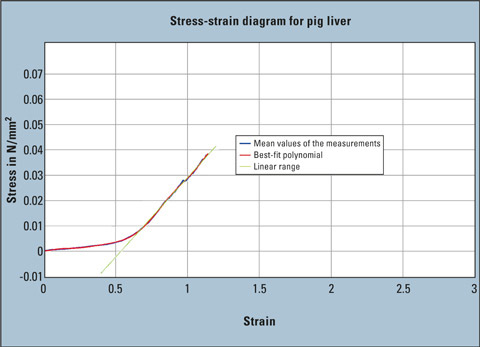 Figure 4: Stress-strain diagram for pig liver: representation of the mean values of the measurements without outliers (blue), the best-fit polynomial (red) as well as the linear range (green)
Figure 4: Stress-strain diagram for pig liver: representation of the mean values of the measurements without outliers (blue), the best-fit polynomial (red) as well as the linear range (green)
The ‘replacement liver’ found this way is currently used in surgical simulations (Figure 5) as well as for the continued study of laparoscopic gripping devices. The replacement material therefore also serves in additional studies to formulate a defined load for the medical instrument industry. In this way, it is possible to investigate locking mechanisms that enable tissues to be clamped over longer periods of time without excessive strain. The target is to develop a gripping mechanism that will, on the one hand, meet ergonomic requirements for the protection of the doctor as well as being easy to apply and to release. On the other hand, a longer clamping duration shall not lead to any damage of the patient’s tissues.
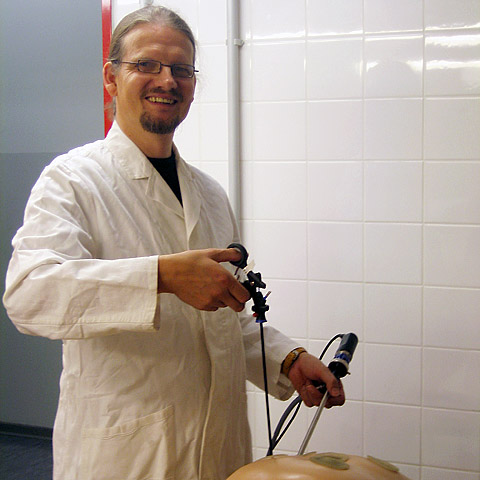 Figure 5: Simulation of a laparoscopic gall bladder removal using artificial materials
Figure 5: Simulation of a laparoscopic gall bladder removal using artificial materials
In contrast to the use of animal material, all studies on the use of synthetic materials are reproducible. In addition, the results can be compared with each other. Realistic replacement materials therefore offer an important foundation for all relevant studies.
Literature
- DIN EN ISO 527-1: 2010 Kunststoffe – Bestimmung der Zugeigenschaften / Plastics – Determination of tensile properties
- Donner, S.; Kraft, M. (2010): Potentiale zur verbesserten Gestaltung von minimalinvasiven Chirurgieinstrumenten – Auswertung einer Befragung unter laparoskopisch operierenden Chirurgen. In: Grundlagen – Methoden – Technologien / 5. VDI Fachtagung Useware 2010. Baden-Baden, 13. und 14. Oktober 2010. Düsseldorf: VDI-Verlag, S. 179-188
- Mazza, E.; Grau, P.; Hollenstein, M.; Bajka, M. (2008): Constitutive Modeling of Human Liver Based on in Vivo. MICCAI 2008, Part II, LNCS 5242, 2008: 726-733
- Ohara, T (1953): On the comparison of strengths of the various organ-tissues. J. Kyoto Pref. Med. Univ., 53: 577-597
- Yamada, H (1970). Strength of Biological Materials. The Williams & Wilkins Company, Baltimore, 1970